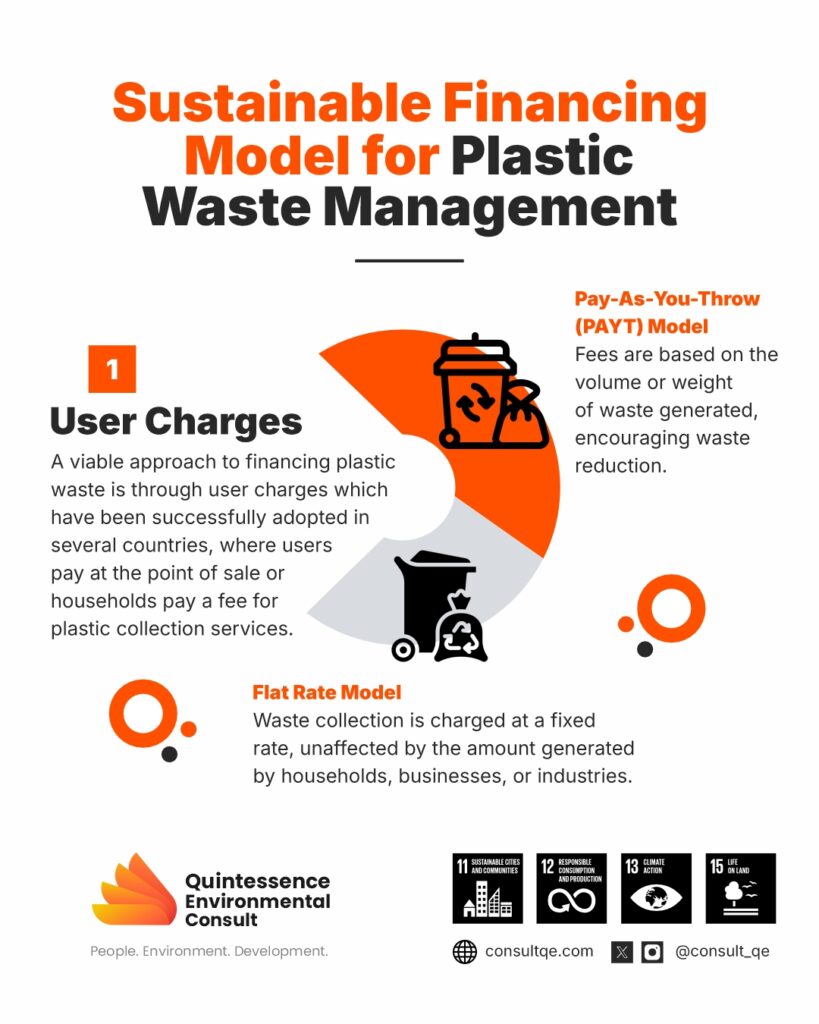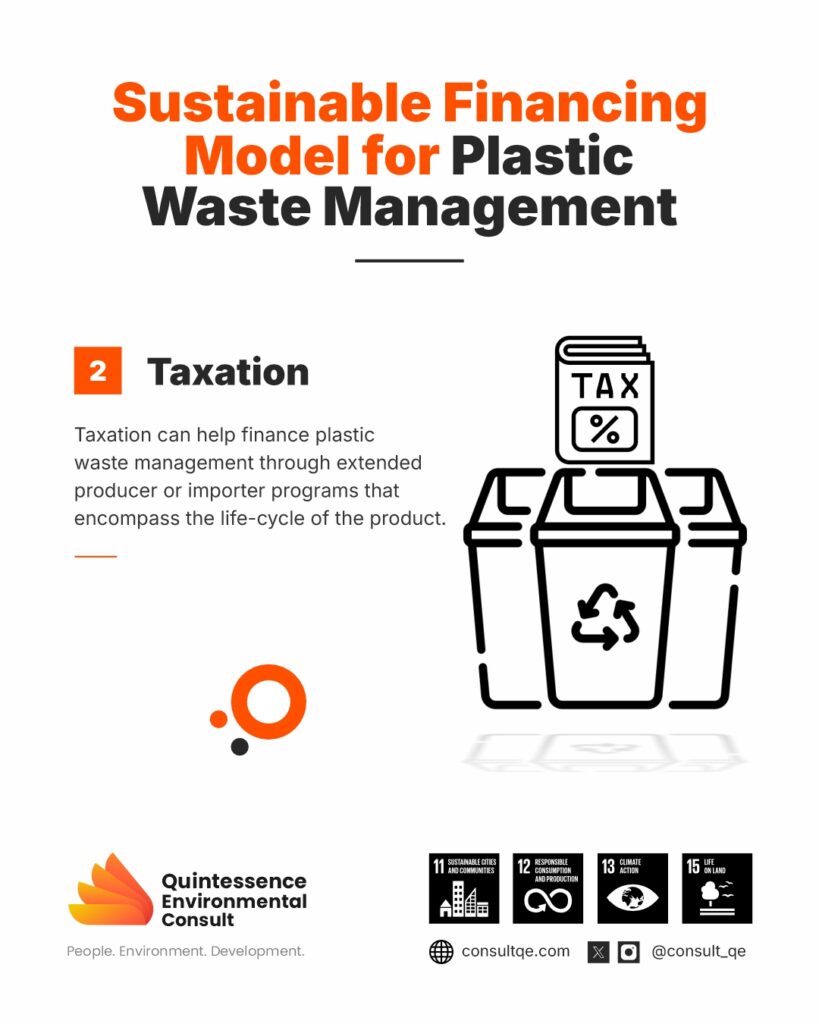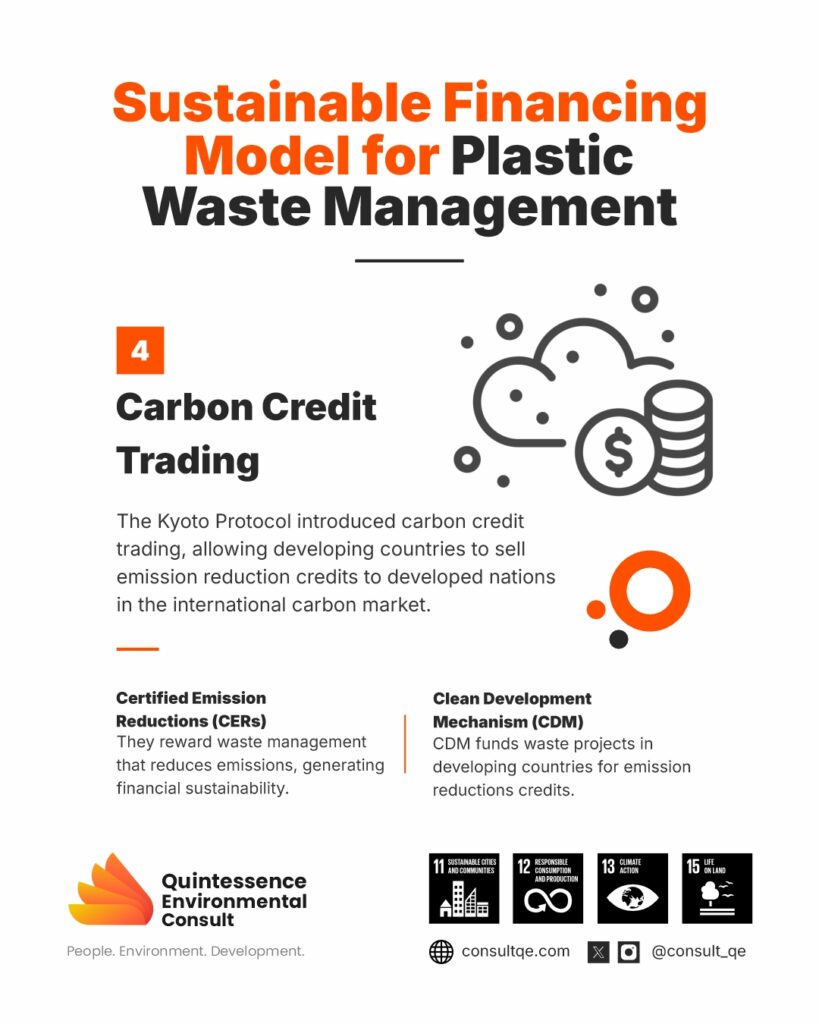KEY TAKEAWAYS
- A truly sustainable financing model does not rely solely on budgetary allocations from local authorities but instead harnesses diverse funding sources such as waste recovery and recycling, taxation, plastic credit systems, user charges, and carbon trading mechanisms.
- Increasing plastic collection efficiency and recovery rates can significantly improve the financial viability of recycling, covering up to 4.64% of plastic waste management costs per 1% increase in recovery.
- Imposing an additional 1% tax on imported plastic-related materials can generate revenue for waste management while also encouraging local recycling and reuse efforts.
- In Carbon Credit Trading proper plastic waste management can qualify for Certified Emission Reductions (CERs) under the Kyoto Protocol, generating up to 1.2 times the income from traditional recycling efforts.
- A plastic credit market, linked to a Recyclability Index (RI), can encourage manufacturers to use more recyclable plastics, promoting a self-regulated, circular economy.
INTRODUCTION
Analysis indicates that between 1.5 and 2.7 billion people lack effective waste collection. The result is that 20 % of total municipal plastic waste is emitted into the unregulated system globally (1). If not managed properly, plastic waste produces negative externalities and contributes to flooding and waterlogging. Effective plastic waste management is essential to cutting emissions and ensuring the economy’s circularity. However, local authorities in low- and middle-income countries often lack the finance necessary to invest in Solid Waste Management. For many municipal authorities in developing countries, solid waste management is a high-cost activity, which may command up to 50% of the total municipal budget (2).
Investment in solid waste management is often deprioritized in favor of competing needs such as education and healthcare. However, there is an urgent need to make Municipal Solid Waste (MSW) management cost-effective and financially sustainable. A sustainable financing model requires minimal or no budgetary allocations from local authorities. This approach leverages developmental financing derived from various waste management practices, including recovery and recycling, taxation, plastic credit, and user charges.

TAXATION
In cases where collection costs are high and revenue from recycling is low, taxation can be an alternative financing mechanism. In low-performing cases, revenue from recovered and recycled plastic materials may cover as little as 22% of plastic-related waste management costs. To bridge this gap, governments can introduce an additional 1% tax on imported plastic-related materials. (5) This taxation strategy serves two purposes:
- Generating additional revenue for plastic waste management.
- Encouraging local recycling and reuse by making imported plastics more expensive and promoting domestic waste recovery efforts.
DEVELOPMENT FINANCING
Development financing is a collaborative effort by international institutions and donor agencies to support sustainable initiatives in developing countries. It involves grants, in-kind assistance, and concessional loans from bilateral and multilateral donors, such as the World Bank Group, the African Development Bank, and the Asian Development Bank.
Despite the critical role of development financing, only 0.41% of all development financing is directed toward solid waste management and only 8% of this funding benefits low-income countries. In 2021, only $1.8 billion was committed to plastic waste management, far below the $30 billion required to mitigate plastic pollution at an acceptable level. To address this financing gap, a multilateral environmental agreement known as the Plastic Treaty is currently under negotiation to increase global commitments toward reducing plastic waste. (6)

CARBON CREDIT TRADING
The Kyoto Protocol introduced carbon credit trading, allowing developing countries to sell emission reduction credits to developed nations in the international carbon market. Suppose a country can demonstrate a reduction in greenhouse gas (GHG) emissions through proper plastic waste management. In that case, it becomes eligible for Certified Emission Reductions (CERs), which can be traded for financial gain. (7)
Another mechanism for carbon financing is the Clean Development Mechanism (CDM). Under CDM, a developed country invests in solid waste disposal projects in a developing country and, in return, claims some or all of the emission reductions as part of its environmental commitments.
Studies suggest that revenue from carbon credit trading could provide up to 1.2 times the income generated from traditional recycling efforts, making it a valuable tool for enhancing financial sustainability in waste management.

REFERENCES
[1] E. C. a. C. A. V. Joshua W. Cottom, “A local-to-global emissions inventory of microplastic pollution,” vol. 633, p. 101–108, 2024.
[2] M. G. H. W. Guerrero LA, “Solid waste management challenges for cities in developing countries,” Waste Manag, vol. 33, p. 220–232, 2013.
[3] D. C. R. L. S. A. V. C. A. &. A. G. Wilson, “Comparative analysis of solid waste management in 20 cities,” Waste Management and Research, vol. 30, no. 3, p. 237–254, 2012.
[4] D. B. Obiora B. Ezeudu, “Financing methods for solid waste management: A review of typology, classifications, and circular economy implications,” Sustainable Development, 2024.
[5] R. K. R. . N. Bishal Bharadwaj, “Sustainable financing for municipal solid waste management in Nepal,” PLoS ONE, 2020.
[6] D. J. Lerpiniere, D. C. Wilson and C. A. Velis, “Official development finance in solid waste management reveals insufficient resources for tackling plastic pollution: A global analysis of two decades of data,” 2025.
[7] E. d. R. F. A. R. E.A. McBean, “Improvements in financing for sustainability in solid waste management,” Resources, Conservation and Recycling, vol. 43, no. 4, pp. 391-401, 2004.
[8] C. L. a. F. M. Xiaoshuai Zhang, “A Smart-Contract-Aided Plastic Credit Scheme,” IEEE SYSTEMS JOURNAL, vol. 17, no. 1, pp. 1703 – 1713, 2023.




Very insightful